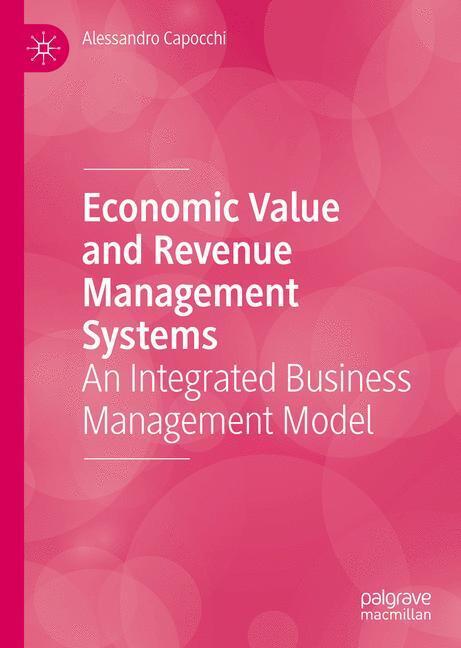Economic Value and Revenue Management Systems
An Integrated Business Management Model
Filling a gap in existing literature on revenue management systems, this book explores the use of business strategies which are specifically designed to have a positive impact on economic and financial efficiency. Focussing on services within the tourism industry, the author takes a new approach and identifies dynamic pricing and service differentiation as key components of strategic management. Providing fresh insights into an ever-expanding sector, this book will be a useful tool for those studying business strategy and management, as well as value creation theory, as it ultimately presents an integrated business management model which will ensure sustainability.
Alessandro Capocchi is Associate Professor of Business Economics at the University of Milano-Bicocca, Italy. Here, he is Head of the international office of the School of Economics and Statistics and Scientific Director of the Observatory on New Entrepreneurship (ONILAB). Alessandro is also Co-Founder and president of MIndLab SRL, a Spin Off of the University of Milano-Bicocca, and a member of the Association of North America Higher Education International (ANAHEI).
1;Preface;6 2;Acknowledgments;10 3;Contents;11 4;List of Figures;15 5;List of Tables;17 6;1: Starting and Running a Business;18 6.1;From a Sharing to a Contamination Economy;18 6.2;Business and Entrepreneurship;22 6.3;The Entrepreneur;24 6.4;Entrepreneurship;28 6.5;Innovation and Entrepreneurship;30 6.6;New Entrepreneurship in Italy;32 6.7;Enki Stove: An Italian Start-up;34 6.8;References;35 7;2: Time in Entrepreneurship;38 7.1;The Economic Business Cycle;38 7.2;The Meaning of Price;43 7.3;Management Operations;46 7.4;Measurement of the Management System;48 7.5;The Life Cycle of a Company: Accounting Period;50 7.6;The Time Dimension in Management Operations;53 7.7;References;55 8;3: Entrepreneurship, Business Cycle, and Creation of Value;57 8.1;Accounting and Managerial Tools;57 8.2;The Financial and Economic Dimensions;59 8.3;The Output of General Accounting: Financial Statements;63 8.4;The Balance Sheet;66 8.5;How to Read the Balance Sheet;69 8.6;Profit and Loss Statement;76 8.7;References;82 9;4: The Short-Term Measurement of the Creation of Value: The Importance of Technical Efficiency;83 9.1;Creation of Economic Value: Profitability;83 9.2;The Technical Dimension of Business: Production Capacity and Productivity;85 9.3;Technical Efficiency and Economic Efficiency;86 9.4;The Relationship Between Volumes, Costs, Prices, and Revenues;89 9.5;The Origins of Kreislauf: Marginalist Theory;93 9.6;John Maurice Clark and the Division Between Fixed and Variable Costs;97 9.7;References;99 10;5: The Impact of Technical Inefficiency on Business Management;100 10.1;The Illusion of Low Cost;100 10.2;The Importance of the Warehouse in the Business-Economics Dimension;106 10.3;Overbooking: A Virtual Warehouse;110 10.4;Case Study;113 10.5;References;114 11;6: Revenue Management from a Business-Economics Perspective;116 11.1;From Technical Efficiency to an RM System;116 11.2;The Definition of RM;118 11.3;The Principles of RM;122 11.4;The Cannibalization Effect;127 11.5;The Implementation of RM Systems;129 11.6;References;132 11.6.1;Recommended Readings;132 12;7: Revenue Management Systems Based on Dynamic Pricing;135 12.1;Pricing Models;135 12.2;Prospect Theory;137 12.3;The "Fairness" Concept;140 12.4;Dynamic Pricing Strategies;142 12.5;Dynamic Pricing Models;144 12.6;Management Implications of RM Systems Based on Dynamic Pricing;148 12.7;References;151 13;8: Revenue Management Systems Based on Capacity Allocation;154 13.1;Capacity Allocation;154 13.2;Case Study;158 13.3;Capacity Allocation and Optimization;159 13.4;Capacity Allocation Control Mechanisms;161 13.5;Capacity Allocation with Two Classes;165 13.6;Littlewood's Rule;168 13.7;The Effectiveness of RM Systems Based on Capacity Allocation;174 13.8;References;177 14;9: The Measurement of Revenue Management Policies: RevPAR and Yield Rate;179 14.1;RM Systems;179 14.2;Indicators in RM Systems;184 14.3;RevPAR and Yield Rate;187 14.4;The Use of the RevPAR and the Yield Rate;196 14.5;References;200 15;10: Economic Value and Revenue Management Systems: Case Studies;202 15.1;Differentiation: UNA Hotels & Resorts and Accor;202 15.1.1;UNA Hotels & Resorts;202 15.2;The CA Hotels Case;205 15.2.1;Direct Costing and Full Costing;205 15.2.2;Rationality and Strategy;207 15.3;Break-Even Analysis;208 15.3.1;Fixed Costs;209 15.3.2;Graphical Representation of the BEA;210 15.3.3;The Mathematical Representation of the BEA;211 15.4;The Unimib Travel Case;213 15.5;The Hotel Vittoria Case;214 15.6;The Hotel Piccadilly Case;215 15.7;Reference;217 16;Index;218
Capocchi, Alessandro
| ISBN | 9783030024178 |
|---|---|
| Artikelnummer | 9783030024178 |
| Medientyp | E-Book - PDF |
| Copyrightjahr | 2019 |
| Verlag | Palgrave Macmillan |
| Umfang | 225 Seiten |
| Sprache | Englisch |
| Kopierschutz | Digitales Wasserzeichen |






